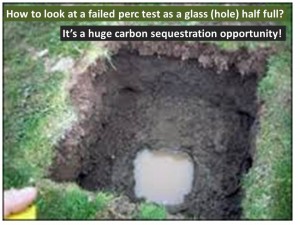Recently Justin, an uber green urban planner I know that is optimizing his new homes’ footprint, asked me about the possible benefits of using biochar to improve the longevity and efficiency of a septic system. Great question! I’m not actually aware of anyone that has dipped their biochar toe into this particular area but it definitely got me pondering possibilities. I’ve already blogged about biochar in French Drains but septic systems offer even more possible opportunities for biochar.
Nearly 30% of American households are reliant on residential septic tanks and surrounding leach fields to process their own wastewater. Before breaking ground to build a house in an area not connected to a municipal wastewater system, a percolation or ‘perc’ test needs to be done to see if soil drainage is sufficient or if a leach field needs to be installed. If you are planning to build on heavy clay soils, expect to fork out plenty of cash to improve drainage. If you need to head in that direction, adding biochar to a leach field could be a great way to filter water before it heads down into the groundwater zone or local water bodies. It could also provide quite a nice carbon sink opportunity if you are looking to build a net zero footprint home especially if the char was made on-sight using some of the trees or other biomass uprooted to make way for the leach field!
Septic tanks themselves might benefit from the introduction of biochar as well (heck maybe they could even be built using biochar concrete!). Septic tanks are anaerobic environments meant to hold solids while allowing most liquids to pass through into the leach field. A few studies (not nearly enough!) have shown that introducing char to an anaerobic environment can have beneficial impacts such as boosting methane generation. But since septic tanks aren’t built for methane capture (no doubt some enterprising engineer is hard at work to come up with a mini generator from septic tanks?), boosting methane isn’t a desired outcome for these systems. However getting rid of some of the grease and fats that clog up the system could potentially extend the period between getting tanks pumped out as well as the overall life of the septic system. By proving housing for beneficial microbes that feed on just such a diet, biochar may be just what the septic system doctor ordered.
There is though, the challenge of how to get the char into the tank. Not to worry, this is not as challenging as it might appear at first flush, er blush! There are at least three easy ways to do it:
- For those ingesting char for health purposes as I do on occasion to keep my tummy in good running order, char will go down the tubes (first yours, then the septic systems).
- For those using biochar in body care products (e.g. soap), char will swirl down the drain in the bath water
- For those with a garbage disposal, a handful of char tossed down the gullet will keep odors at bay while charging the septic tank.
If none of the above is relevant, you can always toss a handful of char into the toilet and watch it swirl away.


